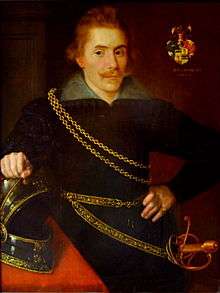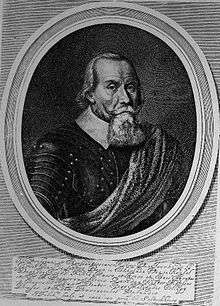Jacob De la Gardie
| Count Jacob De la Gardie | |
|---|---|
 Jacob De la Gardie in 1606 | |
| Lord High Constable of Sweden | |
|
In office 1620–1652 | |
| Preceded by | Axel Nilsson Ryning |
| Succeeded by | Gustaf Horn |
| Governor of Swedish Estonia | |
|
In office 1619–1622 | |
| Preceded by | Anders Eriksson Hästehufvud |
| Succeeded by | Per Gustafsson Banér |
| 1st Governor-General of Swedish Livonia | |
|
In office 1622–1628 | |
| Succeeded by | Johan Skytte |
| Personal details | |
| Born |
20 June 1583 Reval (Tallinn), Swedish Estonia |
| Died |
22 August 1652 (aged 69) Stockholm, Sweden |
| Spouse(s) |
Ebba Brahe (m. 1618–52; his death) |
| Children |
14, including: Magnus Gabriel De la Gardie Maria Sofia De la Gardie Axel Julius De la Gardie |
| Residence |
Makalös Palace, Stockholm Läckö Castle |
Field Marshal and Count Jacob Pontusson De la Gardie (Reval, 20 June 1583 - Stockholm, 22 August 1652) was a statesman and a soldier of the Swedish Empire.
He was appointed Privy Councilor in 1613, Governor of Swedish Estonia between 1619 and 1622, Governor General of Livonia in 1622, and Lord High Constable in 1620. He introduced reforms based on the then novel Dutch military doctrine into the Swedish army. He commanded the Swedish forces in Russia and against the Polish-Lithuanian Commonwealth. He also served as one of the five regents jointly ruling Sweden during the minority of Queen Christina.
Biography
Antoine Marie Jacob De la Gardie was born in Reval (today Tallinn), Estonia (then part of the Swedish Empire), as a son of Pontus De la Gardie and Sofia Johansdotter Gyllenhielm, the illegitimate daughter of king John III of Sweden. His mother died giving birth, and his father perished two years later in Narva. Jacob was raised in the Vääksy (Swedish: Växiö) manor, Kangasala, Finland (then part of Sweden proper) by his grandmother Karin Hansdotter, the mistress of king John III.
Career
As a young adult, De la Gardie was held prisoner in Poland for four years, together with Carl Gyllenhielm. After being released, De la Gardie took part of the Dutch Revolt as a volunteer.[1] Between 1606 and 1608, De la Gardie served under the Dutch general Maurice of Nassau, Prince of Orange. Impressed with the Dutch way of waging war, De la Gardie began introducing Dutch methods into the Swedish army upon his return to the service of Sweden.
During the Polish-Russian War (1605-1618), Sweden signed an alliance with tsar Vasili IV of Russia in 1609. Sweden promised to send troops to the tsar and gained, in return, the County of Kexholm. De la Gardie was put in command of the Swedish force, which consisted of mostly mercenaries, but Swedish and Finnish soldiers as well. This campaign, which eventually took De la Gardie and his troops all the way to Moscow, is known as the De la Gardie Campaign. It ended with a devastating defeat at the Battle of Klushino in the summer of 1610, from which De la Gardie had to retreat.[1]
Not long thereafter, the Ingrian War between Sweden and Russia was initiated, during which De la Gardie played a significant part militarily. He also claimed that Sweden should take advantage of the ongoing turmoil in Russia, later known as the Times of Trouble, and try to place Charles Philip, younger brother of the Swedish king Gustavus Adolphus, on the Russian throne. After some negotiating, these plans were abandoned due to lack of engagement from Gustavus Adolphus and uncertainty on the Russian side.[2]
In 1617, De la Gardie became the chief Swedish negotiator at the Treaty of Stolbovo that ended the Ingrian War, whereby Sweden was able to secure important territorial concessions from Russia, effectively closing off Russia from access to the Baltic Sea.
Between July 1619 and 1622 was Governor of the Swedish Estonia and in 1626 De la Gardie purchased an estate with a medieval castle in Haapsalu, in modern-day Estonia. His time as governor of Estonia was followed by a time as Governor-General of Swedish Livonia 1622-1628.
After 1621, De la Gardie took part in the Polish-Swedish War against his mother's half-brother King Sigismund III of Poland (former king of Sweden) in Livonia, but he was recalled after serving as commander in chief between 1626 and 1628. De la Gardie was an advocate of peace with Poland and acted as one of the Swedish negotiators at the Truce of Stuhmsdorf in 1635.
In the Privy Council

De la Gardie became a member of the Swedish Privy Council in 1613. In 1620 he became Lord High Constable and, as such, he was later one of the five regents ruling Sweden during Queen Christina's minority (1632–44). His pacifist and pro-French and pro-Polish attitudes often put him at odds with chancellor Axel Oxenstierna, who led Sweden's war effort in the Thirty Years' War after the death of Gustavus Adolphus in 1632.
As De la Gardie supported many of Oxenstierna's other policies, eventually the two leaders reconciled after Oxenstierna's return to Sweden in 1636. Although the marshal's office came under criticism that year, De la Gardie continued to operate effectively, making large profits from leasing royal revenues and from loans to the crown.
Family life
in 1618, De la Gardie married Ebba Brahe, the love of young Gustavus Adolphus. The couple had 14 children, the most famous among them being Magnus Gabriel De la Gardie, Maria Sofia De la Gardie, Axel Julius De la Gardie and countess Christina Catharine De la Gardie (1632–1704), who married Gustaf Otto Stenbock and was mother of Magnus Stenbock.
Death and legacy
Count Jacob De la Gardie died in Stockholm in 1652 and is buried in Veckholm church in Uppsala County. The city of Jakobstad in Finland is named after him. A shopping mall in Old Tallinn is named De la Gardie in honour of Jacob De la Gardie. During the De la Gardie Campaign, the Finnish soldiers nicknamed their commander Laiska-Jaakko ("Lazy Jacob") due to the unusually lengthy six-year occupation of Novgorod. This name is still widely remembered in Finland. The siege was thus recorded in folk verse: Lähti suvi, lähti talvi, vaan ei lähde Laiska-Jaakko. (The summer left, the winter left, but Lazy Jacob is still here.)
References
- Läckö Castle (The castle of Magnus Gabriel De la Gardie) at Statens fastighetsverk
- Jacob De la Gardie (1583-1652) Image at heninen.net
- Jaakkima - Lahdenpohja at heninen.net
